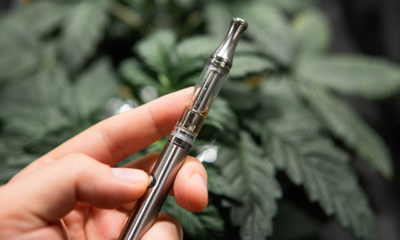
Joint Opinions
The Great Vaporizer Panic Is a Grifter’s Paradise
As public health officials urge caution — and to stop vaping until the exact cause of a lung ailment can be identified — some bad-faith actors aren’t letting a crisis go to waste.
“You never want a serious crisis to go to waste… it’s an opportunity to do things that you think you could not before.” – Rahm Emanuel
Nobody knows exactly what’s caused 530 Americans to fall ill with vaping-associated pulmonary illness, nine of whom are dead, after using vaporizer products — some with THC oil, some with nicotine or other flavored “vape juices,” some who used both.
And yet somehow, many people know exactly what to do. Conveniently, it’s exactly what they’ve always wanted to do, well before the first vape-related illness was made public.
From pushing outright bans (that seem destined only to help the underground market, where many of the vape carts in question originated) to shamelessly pushing misinformation to prop up their preferred hobbyhorse, the confusion and very real fear are providing opportunistic grifters the perfect cover.
Though there are some commonalities — the use of vape products, symptoms including shortness of breath, chest tightness, dizziness, and vomiting, consistent with lipiod pneumonia — both the identity of the offending products as well as the potentially deadly contaminant within are still not known, as Oregon Health Authority spokesman Jonathan Modie told Cannabis Now on Tuesday. To date, Oregon — where cannabis is legal and sold in stores regulated by the Oregon Liquor Control Commission — counts five victims and one fatality. All are believed to have visited legal dispensaries and purchased vaporizer cartridges — but whether it was those products or something else that caused them to fall ill just isn’t known yet, Modie said.
Variations of this “we don’t know yet, it’s too early to tell” are what you’ll hear from health officials on every level, from the states where vaporizer products are sold (and at least in the case of cannabis products sold at dispensaries, regulated) to the national Centers for Disease Control and Prevention and federal Food and Drug Administration. The FDA is in the process of analyzing cartridges sent by the states for testing.
Until the exact cause can be identified, the best course of action is to stop vaping altogether, as California Department of Public Health officials advised on Tuesday. In that state, home to both the largest legal and illegal cannabis markets in the world — as well as an enormous wholesale market where bootleg vaporizer cartridges and potentially harmful thickening agents are available for cash on the spot — as many as 90 people have fallen ill, with two deaths. But again, the cause is not known.
“There are numerous unknown factors at this time, and due to the uncertainty of the exact cause, it is our recommendation that consumers refrain from vaping until the investigation has concluded,” said Charity Dean, a physician and assistant director of the California DPH.
In the meantime, elected officials who have never really liked marijuana from the beginning are moving to ensure that the only place cannabis vaping products will be available is the underground market. On Tuesday, Massachusetts Gov. Charlie Baker — who vehemently opposed marijuana legalization in 2016, before deciding to accept political contributions from the industry — announced a four-month ban on all vaping products, cannabis and nicotine.
Massachusetts’s proposed ban is the country’s strictest by far. Other states to enact bans, like Michigan, where cannabis is also legal, did not include marijuana in its ban as Baker did.
Though public-health officials said they would devote extra resources to cigarette users to help keep them from taking up smoking to get their nicotine fixes, there doesn’t appear to be any such provision for cannabis users. They can smoke weed — but then again, with public smoking bans and strict rules on cannabis use in apartments and elsewhere, can they?
Though in some states sales of vaporizer cartridges have been outpacing sales of traditional cannabis flower (use of which has not been associated with deaths or serious lung ailments) in the wake of the crisis, the public appears to be heeding health officials’ advice. Sales of vape devices at legal dispensaries in states like Oregon have plummeted — leaving a gaping inefficiency in the market that online retailers operating in a wholly unregulated space have been happy to fill, as the Wall Street Journal reported.
This is a terrible decision. Purposely pushing people into the illicit market — precisely where the dangerous products are — goes against every principle of public health and harm reduction. It is dangerous, short-sighted, and undermines the benefits of legal regulation. https://t.co/57OaVYf5nY
— Shaleen Title (@shaleentitle) September 24, 2019
At least so far, the vape crisis hasn’t upended long-awaited and still-popular plans to legalize cannabis. New York Gov. Andrew Cuomo, whose state moved to limit the sales of flavored e-liquids, said Tuesday that he remains “serious” about legalization, but will push for some sort of regional framework that would see New York, Connecticut and New Jersey share similar laws.
But not for lack of trying. Also on Tuesday, America’s leading anti-legalization group used the crisis — and specifically Massachusetts Gov. Baker’s announced ban — to spread misinformation. Specifically, Kevin Sabet, executive director of Smart Approaches to Marijuana (which from the beginning has labeled the crisis the #PotVapingCrisis, happy to ignore the teens and other victims who publicly copped to using JUUL pods and nicotine products) capitalized on the confusion to push the line that the offending products had all been purchased from legal outlets.
When confronted with the statements from the Oregon Health Authority and others maintaining that it was too early to make such a pronouncement, Sabet declined to comment.
In this way, the vaping crisis has something for everybody — everybody except those of us curious to know exactly what’s happening, who to blame, and how to stop it.
TELL US, do you think “vaping crisis” is overblown?


























